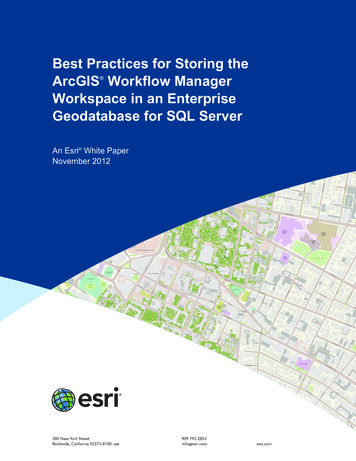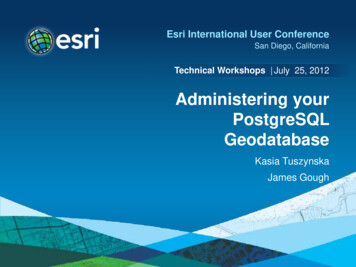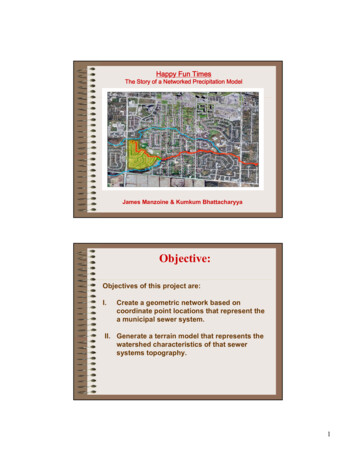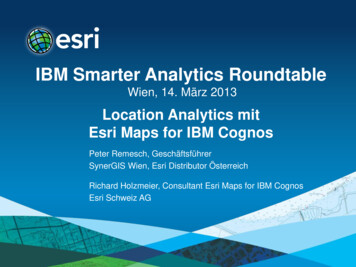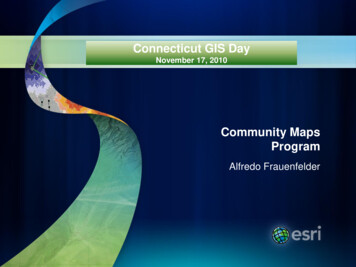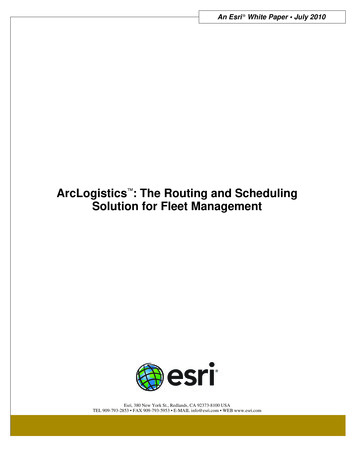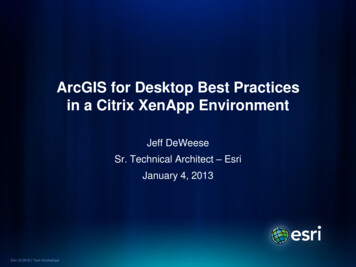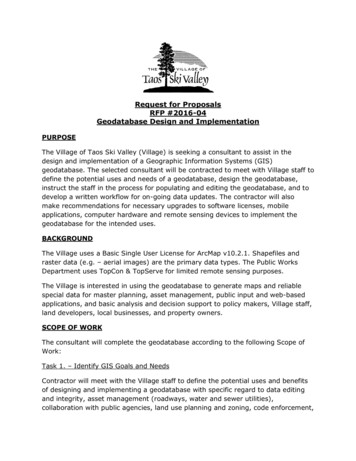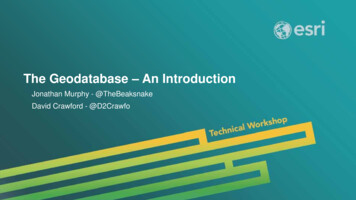
Transcription
The Geodatabase – An IntroductionJonathan Murphy - @TheBeaksnakeDavid Crawford - @D2CrawfoEsri UC 2014 Technical Workshop
Getting StartedThe Geodatabase: An Introduction This is an intro session Please hold questions until the end Please turn off or silence cell phonesThis is us getting started!Esri UC 2014 Technical Workshop The Geodatabase: An Introduction
Roadmap The Geodatabase What is it? Why use it? What types are there? Inside the Geodatabase Advanced Behavior Geodatabase PotpourriEsri UC 2014 Technical Workshop The Geodatabase: An IntroductionEsEsri
ArcGIS Is a PlatformEnabling Web GIS alServerOnline Content andServicesAvailable in the Cloud . . . . . and On-PremisesEsriEssrir UC 2014 Technical WorkshopW ororksk hohopp
Geodatabases File Geodatabases- System files in a file folderEnterprise Geodatabases-Support major database platforms:-DB2, Informix, PostgreSQL, SQL Server, Oracle-and now Netezza and TerradataEsri UC 2014 Technical Workshop Geodatabase Administration: An Introduction
Demo 1Working with Geodatabases Campus place finder Look behind the mapEsri UC 2014 Technical Workshop The Geodatabase: An IntroductionEsEsri
What is the Geodatabase? Core ArcGIS data model A comprehensive model for representing and managing GIS dataA physical store of geographic data Scalable storage model supported on different platforms A transactional model for managing GIS workflows Set of COM components for accessing dataEsri UC 2014 Technical Workshop The Geodatabase: An Introduction
Why use the Geodatabase? Simple! Robust, customizable framework Build and manage your own specific GIS solutionThe model to best support the ArcGIS platform within an organizationEsri UC 2014 Technical Workshop The Geodatabase: An Introduction
Types of Geodatabases File Geodatabase Cross platform Single editor, multiple readersEnterprise Geodatabase Stored in an enterprise DBMS-DB2, Informix, PostgreSQL, SQL Server, Oracle-and now Netezza and TerradataSupports multi-user editing via versioningEsri UC 2014 Technical Workshop The Geodatabase: An Introduction
Geodatabase Data Management Schema is defined in the Catalog Window Define feature classes, datasets, relationships Import and convert data from other formats Shapefile Coverage CAD Raster Copy and Paste ArcGIS Online Import basemaps and layers from galleries, groups Use an esri Solution Industry specific data models available onlineEsri UC 2014 Technical Workshop The Geodatabase: An Introduction
Editing Geodatabases ArcGIS datasets in the geodatabase are editable Modify building footprints in parcel management Add water mains to a water network Update land owners information stored in a table Etc Transaction model for editing in ArcGIS Edits are performed in an edit session Open session – edit – save edits / don’t save editsA series of edit operations constitutes a transaction The transaction is either committed or rolled backEsri UC 2014 Technical Workshop The Geodatabase: An Introduction
Editing Geodatabases File Geodatabase Mainly single user editing small to very large datasets Multiple readers Editing locks at the dataset level Multiple editors cannot edit the same table or stand-alone feature class at the same time Multiple editors cannot edit feature classes in the same feature dataset at the same timeEsri UC 2014 Technical Workshop The Geodatabase: An Introduction
Editing Geodatabases Enterprise Geodatabases Extend the transaction model with Versions Multiuser editing without locking Unique isolated view of the geodatabaseBenefits of versioned editing Multiple editors, editing over long periods of time Undo / Redo Archiving ReplicationEsri UC 2014 Technical Workshop The Geodatabase: An Introduction
Demo 2Creating a GeodatabaseUsing CatalogCreating a GeodatabaseLoading existing dataEsri UC 2014 Technical Workshop EsEsri
Roadmap The Geodatabase Inside the Geodatabase--Object Classes, Feature Classes, RastersFeature DatasetsValidation RulesDomains, Subtypes, Relationship ClassesAnnotation, DimensionsExploring a Geodatabase – DEMO! Advanced Behavior Geodatabase PotpourriEsri UC 2014 Technical Workshop The Geodatabase: An IntroductionEsEsri
Inside the Geodatabase A geodatabase contains datasets represent collections of information with a real-world interpretationTypes of geographic datasets:Tables, feature classes, raster Feature datasets Networks, Topologies, Terrains Datasets have associated informationDomains, Relationship classes, Topology Manage integrity, behavior, and interpretation Esri UC 2014 Technical Workshop The Geodatabase: An Introduction
Objects and Object Classes – Tables Objects are entities with properties and behavior Each row in the table is an object All objects in an object class have the same properties and behaviorEsri UC 2014 Technical Workshop The Geodatabase: An Introduction
Objects and Object Classes – Tables Objects are entities with properties and behavior Each row in the table is an object All objects in an object class have the same properties and behaviorEsri UC 2014 Technical Workshop The Geodatabase: An Introduction
Features and Feature Classes Builds on the Relational Model A feature is a spatial object A feature is an instance of a feature class Extended the relational model Geometry attribute typeA feature class is a table of rows, where each row has ageographic columnEsri UC 2014 Technical Workshop The Geodatabase: An Introduction
Features and Feature Classes Builds on the Relational Model A feature is a spatial object A feature is an instance of a feature class Extended the relational model Geometry attribute typeA feature class is a table of rows, where each row has ageographic columnEsri UC 2014 Technical Workshop The Geodatabase: An Introduction
Geodatabase Supports Advanced Geometry Point, lines, polygons Single and multipart featuresFeature with many parts Text and surfaces Flexible coordinates XY, Z, MEsri UC 2014 Technical Workshop The Geodatabase: An IntroductionOne record in feature class table
Raster and Imagery Support for many formats Grid, MrSID, TIFF, etc Attribute field in a table Mosaic dataset Data model for managing raster collections Stored as a catalog, viewed as a mosaic Advanced querying and processingEsri UC 2014 Technical Workshop The Geodatabase: An Introduction
Feature Datasets A container object for other datasets SubdivisionSame spatial referenceParcelCorner Analogous to a coverage Less restrictiveContain geometric networks, topologies,terrains, etc Optionally relationship classesParcelParcelAnnoLotLinesParcel TopoLotDimensionsBoundryLinesEsri UC 2014 Technical Workshop The Geodatabase: An Introduction
Validation Rules Attribute, connectivity, and relationship rules Stored on objects as part of the geodatabasePredefined, parameter driven Attribute range rule Attribute set rule Connectivity rulePerform custom validation by writing codeEsri UC 2014 Technical Workshop The Geodatabase: An Introduction
Domains Describe the legal values of a field type Used to ensure attribute integrity Defined at the geodatabase levelTypes of domains: Range Valid values between a min / max range A tree can have a height between 0 and 300 feet A road can have between one and eight lanesCoded Value Valid values chosen from a set list A tree can be of type oak, redwood, or plain A road can be made of dirt, asphalt, or concreteEsri UC 2014 Technical Workshop The Geodatabase: An Introduction
Subtypes Categorize objects or features into groups Share the same attributes Defined at the class levelSelect a field to base the subtype on Short or long integer field Can have different default values and domains for each field Can define behavior rules between subtypesDescriptionsEsri UC 2014 Technical Workshop The Geodatabase: An IntroductionCodes
Relationship Classes Association between objects in one class and another A class may participate in multiple relationship classes Simple relationships Composite relationships Related objects can message each other Can trigger behavior (cascade delete, move to follow, custom, etc.)Associate rules with relationship classes Each Parcel can have between 1 to 3 BuildingsParcelToBuildingEsri UC 2014 Technical Workshop The Geodatabase: An Introduction
Relationship Classes Association between objects in one class and another A class may participate in multiple relationship classes Simple relationships Composite relationships Related objects can message each other Can trigger behavior (cascade delete, move to follow, custom, etc.)Associate rules with relationship classes Each Parcel can have between 1 to 3 BuildingsParcelToBuildingEsri UC 2014 Technical Workshop The Geodatabase: An Introduction
Annotation Annotation feature classes Placing text and graphics on the map Feature linked or Non-feature linked Composite relationship manages link Can store text as well as other graphics Lines, arrows, boxes, etc Visible scale rangeFeature ClassCompositeRelationship classAnnotationFeature 479595Topanga Canyon49Esri UC 2014 Technical Workshopp ThThe Geodatabase:G d t bAnA IntroductionI t d ti
Dimension Features Type of annotation that displays specific distances on a map Graphic features stored in a dimension feature class Can be created automatically from features Set of editing tools Define a style, description of symbology1 3/8"Esri UC 2014 Technical Workshop The Geodatabase: An Introduction
Object Behavior You can: Control the default value and acceptable values for any attribute. (Domains) Partition the objects into like groups. (Subtypes) Instantiate classes with predefined behavior. (Dimensions and Annotation) Control the general relationships in which an object can participate.(Relationship Classes)Out of the Box in ArcGIS! Configurable, no programming requiredEsri UC 2014 Technical Workshop The Geodatabase: An Introduction
Demo 3Exploring a GeodatabaseTables / Feature ClassesSubtypesDomainsRelationship ClassesEsri UC 2014 Technical Workshop EsEsri
Roadmap The Geodatabase Inside the Geodatabase Advanced Behavior-- AttachmentsGeometric NetworksNetwork DatasetsGeodatabase TopologyAdvanced Behavior DEMOGeodatabase PotpourriEsri UC 2014 Technical Workshop The Geodatabase: An IntroductionEsEsri
Attachments Associate any type of file with a feature Available on a Feature Identify In ArcMap if the file type is known by the OS it can be directlyaccessed.Esri UC 2014 Technical Workshop The Geodatabase: An Introduction
Geometric Networks Uses edges and junctions to model network systems Built in a feature dataset Each feature class has a role in the networkConnectivity relationships between feature classes Based on geometric coincidence Can associate connectivity rules with the network Connectivity is maintained on the flyEsri UC 2014 Technical Workshop The Geodatabase: An Introduction
Geometric Networks A geometric network is associated with a logical network Each network feature is associated with one or more elements in the logicalnetworkTrace solvers on the logical network provide Connectivity tracing, cycle detection, flow directions Upstream / downstream tracing, isolation tracingDownstream TraceEsri UC 2014 Technical Workshop The Geodatabase: An Introduction
Network Datasets Network designed for the transportation industry Multimodal scenarios Edges & Junctions Attributes Properties to control traversability Travel time, restrictions, speeds On-the-fly calculation of costs Improves analysisEsri UC 2014 Technical Workshop The Geodatabase: An Introduction
Network Datasets Multimodal Points span multiple connectivity groups Used to create connectivity between lines in different groups Turns Turns do not alter connectivity, but traversability (e.g. U-Turn restriction)Esri UC 2014 Technical Workshop The Geodatabase: An Introduction
Geodatabase Topology A topology manages a set of simple feature classes that sharegeometry Topology is used to: Constrain how features share geometry Define data integrity rules Validate features Ensure the quality of your dataEsri UC 2014 Technical Workshop The Geodatabase: An Introduction
Topological Integrity Create topologies in a feature dataset Participating feature classes / subtypes Cluster tolerance, ranks and rules Define rules when creating the Topology Cluster Tolerance for XY and ZRules are evaluated during validationViolations are expressed as error features Managed in the database as a part of the topology Error and Exceptions Examine and Fix errors in ArcMapEsri UC 2014 Technical Workshop The Geodatabase: An Introduction
Topology Error Examples Rules enforced to maintain topological integrity 25 topology rules in ArcGISEsri UC 2014 Technical Workshop The Geodatabase: An Introduction
Editing with a Topology Editing creates a dirty area- Area has been edited and may contain errors- Can be symbolized Errors are found during validation- Errors have properties -What rule was violated-Which feature(s) created the errorYour options:- Ignore the error- Mark as exception- Fix the errorEsri UC 2014 Technical Workshop The Geodatabase: An IntroductionParcels overlap
Demo 4Exploring a GeodatabaseTopologyGeometric NetworkAttachmentsEsri UC 2014 Technical Workshop EsEsri
Roadmap The Geodatabase Inside the Geodatabase Advanced Behavior Geodatabase Potpourri--TerrainsCartographic representationsParcel fabricsGeocodingEsri UC 2014 Technical Workshop The Geodatabase: An IntroductionEsEsri
Terrains Massive point datasets, multi-resolution, on-the-fly TINDataset for modeling 3D surfaces Modeled within a feature dataset User defined terrain (pyramid) levels Different resolutions & vertical tolerancesRequires 3D AnalystExtension to define & edit No license needed to view Esri UC 2014 Technical Workshop The Geodatabase: An Introduction
Cartographic Representations Property of a feature class Stores info about feature symbology One feature class – multiple representations Rules and overrides Representation Management ToolsetEsri UC 2014 Technical Workshop The Geodatabase: An Introduction
Parcel Fabric Solution for parcel data management Pre-10.0 requires the Survey Analyst extension As of 10.0 no longer requires the extension Storage, maintenance and editing of parcels Create in a feature dataset Parcel editor toolbar Streamline workflows Increase spatial accuracyEsri UC 2014 Technical Workshop The Geodatabase: An Introduction
Geocoding Address matching and location services Use a locations description to find a location Coordinates, street name, place namePoints of Interest, addressesAddress locators Rules for interpreting addresses Parsing and matching address elements Standard street components Reference map dataEsri UC 2014 Technical Workshop The Geodatabase: An Introduction
SummaryThe GeodatabaseData model, Storage, Transaction model, COMInside the GeodatabaseDatasets, Validation rules, data behavior and integrityAdvanced BehaviorGeometric Networks, Network Datasets, and TopologyGeodatabase PotpourriTerrains, Representations, Parcel fabrics, GeocodingEsri UC 2014 Technical Workshop The Geodatabase: An IntroductionEsEsri
Questions?Thank you Please fill out the session survey:First Offering ID: 1156Second Offering ID: 1268Online – www.esri.com/ucsessionsurveysPaper – pick up and put in drop boxEsri UC 2014 Technical Workshop The Geodatabase: An IntroductionEsEsri
Esri UC 2014 Technical Workshop The Geodatabase: An Introduction
Esri UC 2014 Technical Workshop Editing Geodatabases The Geodatabase: An Introduction File Geodatabase Mainly single user editing small to very large datasets Multiple readers Editing locks at the dataset level Multiple editors cannot edit the same table or stand-alone feature class at the same time Multiple editors cannot edit feature classes in the same feature .


